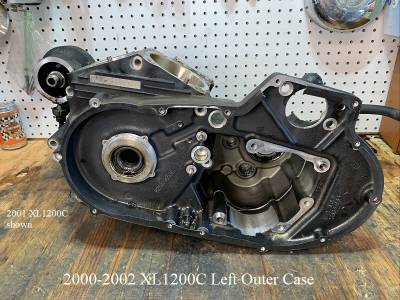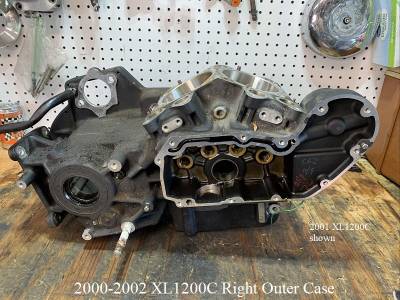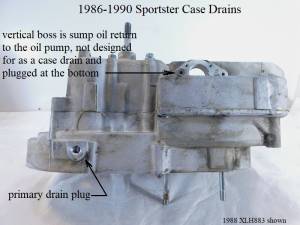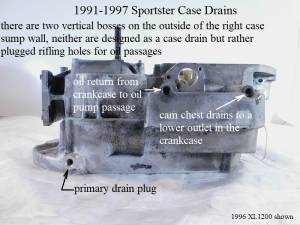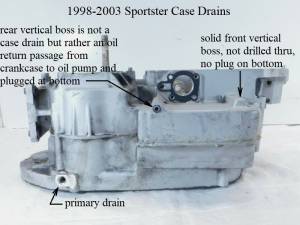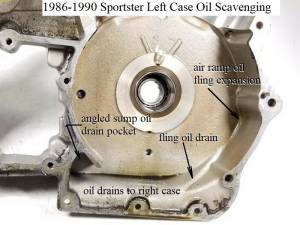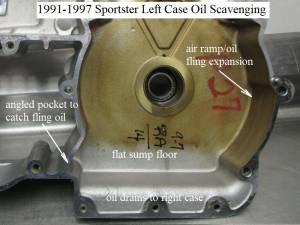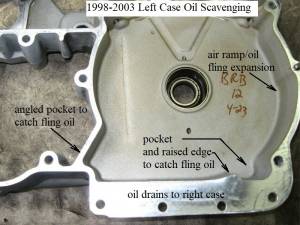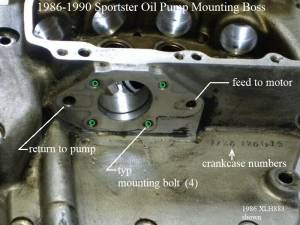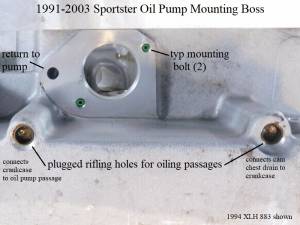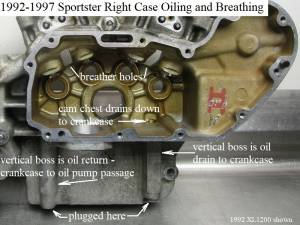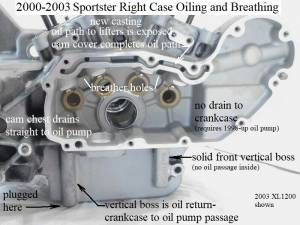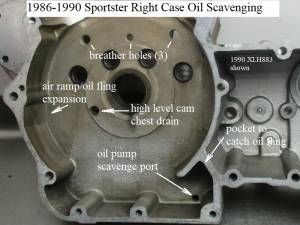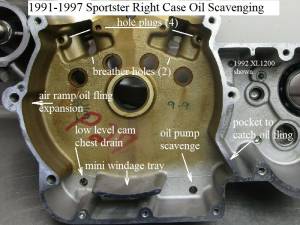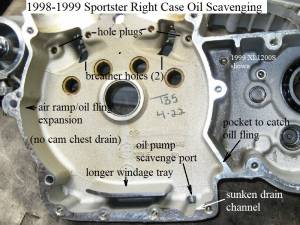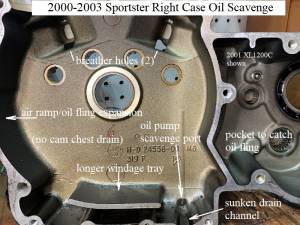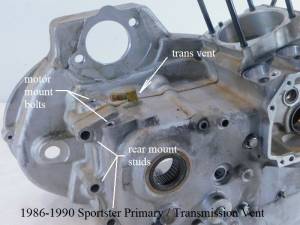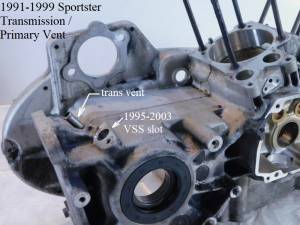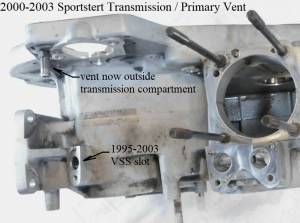Table of Contents
This is an old revision of the document!
EVO: Engine Mechanicals - Sub-01C
1986-2003 Sportster Engine Case Identification
The engine cases below are grouped by the year span they were installed on.
Notice the casting numbers follow the same pattern although there may differences in color and minor machining within a group.
Interchangeability
- Swapping engines and frames:
This is to answer the question of “Will this motor bolt to that frame?”. There are other factors not taken into account in this section.
This is also in consideration of swapping an entire (complete) engine, not mix matched case halves or other functions/features.- Any 1986-1990 engine will be a bolt-on to any 1986-1990 frame.
- Any 1991-2003 engine will be a bolt-on to any 1991-2003 frame.
- 1991-2003 engines will bolt to 1986-1990 frames with the consideration of the kickstand mount on the left bottom tube.
The casing is larger at the front due to the rotor and stator being moved to the crank in 1991.
Otherwise, the motor mounts should all bolt up just fine.- 1986-1988 frames have the jiffy stand mount welded close to the front motor mounts.
The kick stand mount needs to be moved as it interferes with the primary cover on 5 speed cases. - 1989-1990 frames have the jiffy stand mount welded a little further back, just past the center of the oil pump.
You should be able to get the motor in without moving the kickstand mount. 1) - 1991-2003 frames have the jiffy stand mount welded behind the center of the motor mount.
- 1986-2003 motors will also bolt into 1982-1985 frames.
The left bottom tube has the divot to shift the motor as is in 1986-2003 frames.
You'll still have to deal with moving the kick stand on those however.
Welded kickstand mount locations: 2)
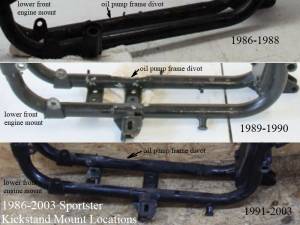
- Swapping engine cases:
Since 1976, the MoCo has not sold left / right case halves individually. They sold replacement cases as a left / right set.
So it's up to the owner to decide if swapping out a case half is the right thing to do as opposed to swapping a matched case set.
Case sets are factory machined / line bored and the precision is not going to be the exact same by swapping out halves from different cases.
Likewise, if you are swapping case halves, make sure to have it done by a competent machinist.
1986-1990 Sportster Cases
- 1986-E1987 (all)
- Case set sold under part# (24527-86).
- Casting numbers and location for each case, Left outer wall (24532-86) and Right outer wall (24552-86).
- E1987 motors received these 1986 cases on a runout basis and 1987 cases were used afterwards for 1987 models.
So there are some early 1987 motors with 1986 (one year only) cases. - Last year of “sand cast” cases.
- 1987-1989 (all)
Early 1987 motors used the last of the 1986 cases (see above).- 1987-1989 style case set sold under part# (24527-87).
- Casting numbers and location for each case, Left inner wall (24534-86) and Right inner wall (24558-86).
- 1987 right case has the same casting number as the 1986 right case.
- 1987-up cases are now “die cast”. The word “Safe Lite” is written in the inner case castings.
- 1990 (all)
- Case set sold under part# (24470-87) and was replacement for 1987-1989 Sportsters.
| 1986 Sportster and some E1987 Left and Right Outer Cases 3) | |
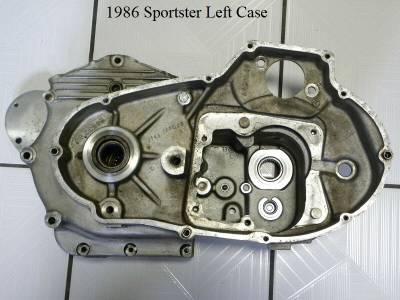 | 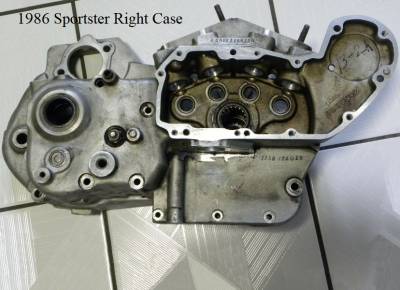 |
| 1987-1989 Sportster Left and Right Outer Cases 4) | |
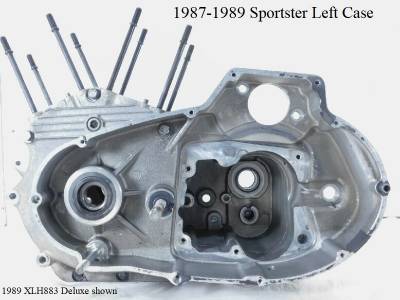 | 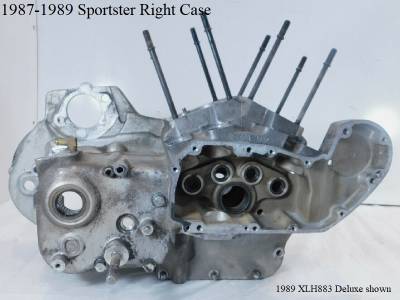 |
| 1990 Sportster Left and Right Outer Cases 5) | |
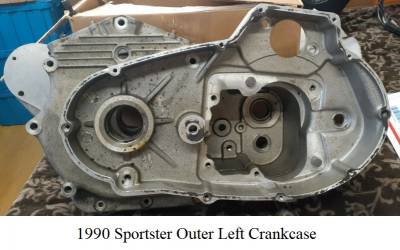 | 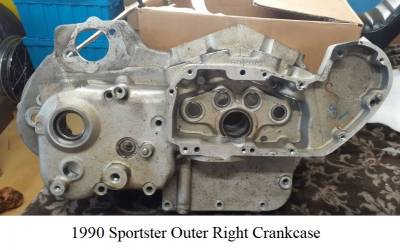 |
| 1990 Sportster Left and Right Inner Cases 6) | |
 | 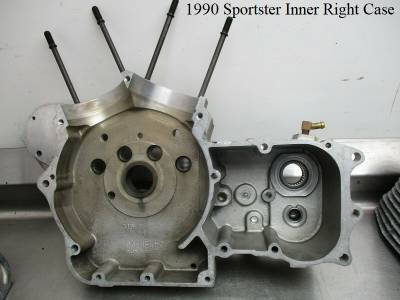 |
1991 Sportster Cases
- 1991 (all)
- One year only case set sold under part# (24470-91).
- A few major changes for the right case was a cast-in oil filter mount and an added high pressure oil bypass valve machined behind the filter mount.
| 1991 Sportster Left and Right Outer Cases 7) | |
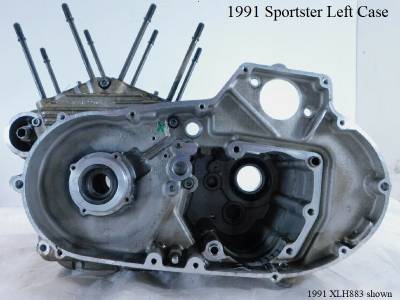 | 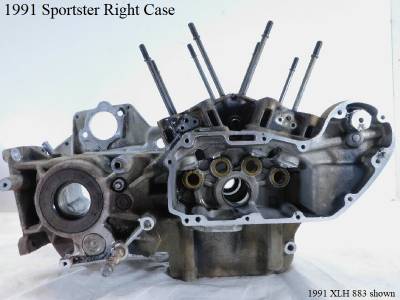 |
1992-1994 Sportster Cases
The oil pressure relief system was deleted as was the discharge hole at the filter pad into the cam chest.
A .060“ hole was drilled from the oil feed galley in the upper right case into the cam chest as a #2 cam squirter.
This hole also doubles as a high pressure oil relief with the excess oil being used to spray onto #2 can gear.
- 1992-1994 (all)
- Case set sold under part# (24470-91B)
- Case casting numbers and locations were the same for all 1992-1994 cases: Left outer wall (24534-89) and Right inner wall (24558-89).
| 1992-1994 Sportster Left and Right Outer Cases 8) | |
 | 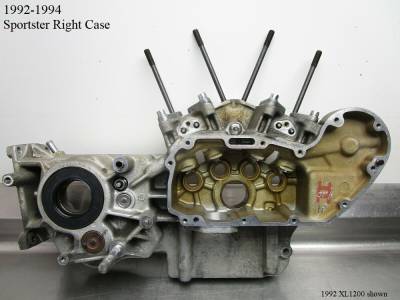 |
| Left and Right Inner Case Views 9) | |
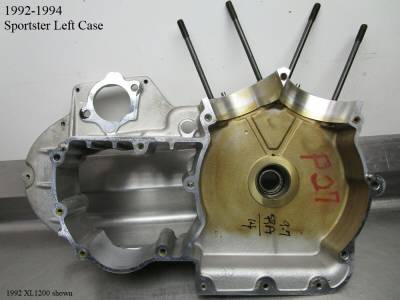 | 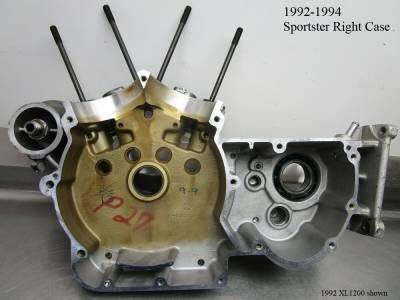 |
1995-1997 Sportster Cases
- 1995-1997 case sets were sold under two different part numbers.
- All models except XL1200C had case set# (24470-91C).
- XL1200C had case set# (24466-96).
- Case casting numbers and locations were the same for all 1995-1997 cases: Left outer wall (24534-89) and Right Inner wall (24558-92A)|
| 1997 XLH883 Left and Right Outer Cases 10) | |
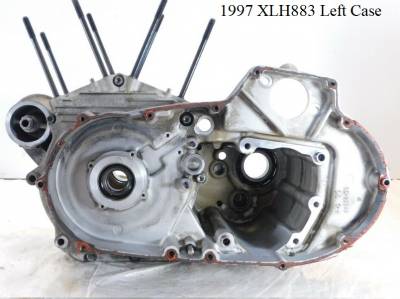 | 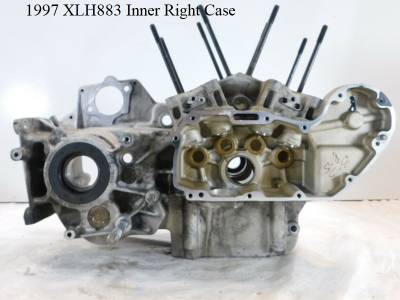 |
| 1996 XLH883 Left and Right Inner Cases 11) | |
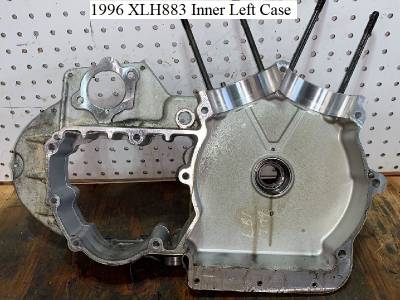 | 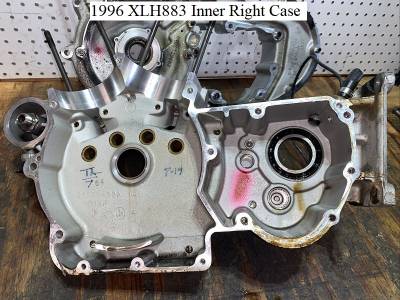 |
1998-1999 Sportster Cases
- 1998-1999 case sets were sold under two different part numbers.
- All models except XL1200C had case set# (24470-98)
- XL1200C had case set# (24466-98, black)
- Case casting numbers and locations were the same for all 1998-1999 cases: Left outer wall (24534-98) and Right inner wall (24558-98)
| 1998-1999 Left and Right Inner Cases 12) | |
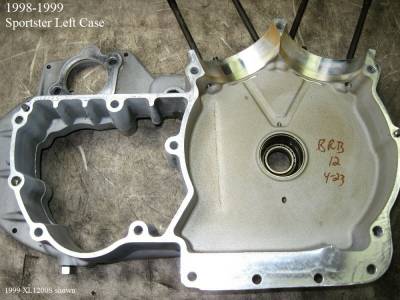 | 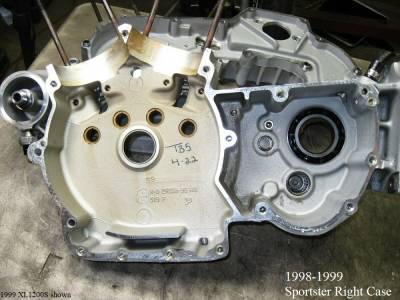 |
2000-2002 Sportster Cases
- 2000-2002 case sets were sold under two different part numbers.
- All (XL883R, XL1200C) had case set# (24470-00)
- XL883R, XL1200C had case set# (24466-00)
- Case casting numbers and locations were the same for all 2000-2002 cases: Left outer wall (24534-98A) and Right inner wall (24558-00)
| 2000-2002 Left and Right Inner Cases 15) | |
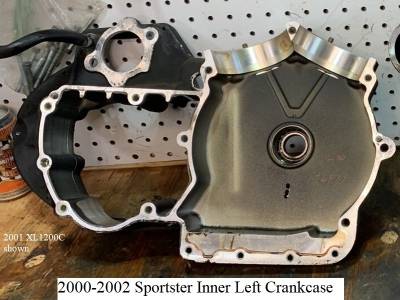 | 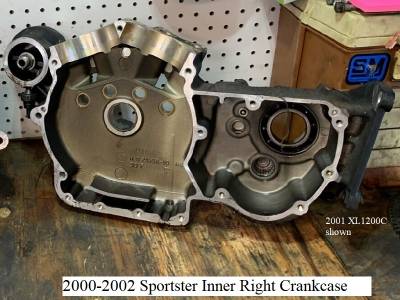 |
2003 Sportster Cases
2003 was the 100th anniversary for HD.
The upper front of the left case was cast for a 100th anniversary medallion sticker just under the front cylinder.
- 2003 case sets were sold under two different part numbers.
- All (XL883R, XL1200C) had case set# (24502-03)
- XL883R, XL1200C had case set# (24500-03)
- Case casting numbers and locations were the same for all 2003 cases: Left outer wall (24555-03) and Right inner wall (24558-00)
Specific Engine Case Features
Motor Vin Pad / Location
Starting in 1970, the bike is titled to the frame only and the same number set is stamped on the motor.
Starting in 1981, the motor VIN is only an abbreviation of the frame VIN.
So the numbers on the motor will not fully match the 17 digit VIN on the frame or the title.
But if it is the motor that came with the frame, it will be the same set of numbers as on the frame but with some left out.
- 1986-1990: The VIN pad is on the right side of the motor between #2 and #3 tappets with the VIN hand stamped into the pad.
The timing hole plug is on the left side of the motor.
- 1991 to March 1993: The VIN pad is the case itself not raised, left side in the second rib down from the top with VIN hand stamped there.
An off center portion of the second rib was deleted and the Vin was hand stamped into that area.
The timing hole plug was moved to the right side of the motor. - April 1993-2003: The VIN is “pin stamped” by machine on the left side of the motor in the same location as 91-E93 and slightly off center.
(more toward the front cylinder and with no raised pad)
HD issued TSB M-1304/1304A explaining the change was to increase manufacturing efficiency.
The pin stamped numbers do not photograph well from afar.
In fact, one has to actually focus on the numbers to get a good picture of them.
Various Numbers Found on Cases
Case Part Numbers
Click Here to see an article on Part Numbers in general in the Sportsterpedia.
You will not find any part numbers on the cases that match the parts listings in the parts catalogs.
Part numbers were never cast or stamped into the cases. Each case half has many numbers on it but none of them show up in the parts books.
There were some parts that did have part numbers on them either stamped or on a sticker label.
Some electrical parts had stickers with the part number on them but no part numbers on cases.
The parts catalog listings are for logistics in which the MoCo stocks parts, sells them to dealerships and customers all under one Part Number.
Basically the part number was created to move the product, not to build the product.
Moving the product can mean, to the builders at the factory, mechanics at the dealership or to the customer.
Part numbers are used in manuals and instructions .
Part numbers are assigned after the parts are built (more accurate to be said the part will be listed as XXXX part number when it gets built).
Each case half has a casting number, not to be confused with a part number. See below.
Beginning with 1976 models and up, cases were only sold as a set so there are no individual part numbers for left or right case halves.
There is only 1 part number that includes both case halves.
Casting Part Numbers
Click Here to see an article on Casting Numbers in general in the Sportsterpedia.
Casting numbers on the left and right cases look like (are coded like) part numbers but they are not.
They were put there when the case half was created (cast) and represent a certain base design.
Unlike part numbers, casting numbers do pertain to the building of the part. One could also call them design numbers.
A casting part number does not pertain to any certain model.
Many different year / model motors may carry the same casting numbers but there will still be differences that are important to know.
When the main design changed, so did the casting numbers, but not until then. However, the part number may change several times.
Some cases with the same casting number will have different machining done for the year model they pertain to.
Some will have different size holes / ports etc. (example of machining done after the part was cast).
Some will be different due to a running change in the way the casting was done.
Casting part numbers per years used:
- 1986 and some E1987 All: 24532-86 (outer wall), 24552-86 (outer wall)
- 1987-1989 All: 24534-86 (inner wall), 24558-86 (inner wall)
- 1990 All:
- 1991 All:
- 1992-1994 All: 24534-89 (outer wall), 24558-89 (inner wall)
- 1995-1997 All: 24534-89 (outer wall), 24558-92A (inner wall)
- 1998-1999 All: 24534-98 (outer wall), 24558-98 (inner wall)
- 2000-2002 All: 24534-98A (outer wall), 24558-00 (inner wall)
- 2003 All: 24555-03 (outer wall), 24558-00 (inner wall)
Casting Date Code
- 1986 Sportsters have a cast-in circled date code on the inside of the left case and an actual date cast into the inside of the right case.
- E1987 Sportsters have an actual date cast into the outside of the right case.
- L1987 Sportsters have a cast-in circled date code on the inside of the left and right cases.
- 1988-1990 Sportsters have stamped date codes inside the left and right cases.
- 1996-1999 Sportster cases have a cast in circled date code in a different format.
Inside the circle, the upper three numbers are the Julian day and one number below them is the seasonal model year intended used on.- Below are a two examples using verified circle date codes as they compare to the crankcase number and VIN of each 1996 motor.
- Example 1: An early 1996 XL883 with a circle date code 193 over number 6, crankcase number 2496 213 050 and VIN sequence 204141.
- Case casting date (creation date): Circle date code 193 over 6 translates to July 12, 1995 (193rd day of year 1995, 1996 season)
- Case machining date: Crankcase number Julian day 213 translates to August 1, 1995 (213th day of 1995)
- Packaging date : VIN sequence number 204141 (low number)
- Example 2: A late 1996 XL1200 with a circle date code 354 over number 6, crankcase number 2596 030 057 and VIN sequence 217798.
- Case casting date (creation date): Circle date code 354 over 6 translates to December 20, 1995 (354th day of 1995, 1996 season)
- Case machining date: Crankcase number Julian day 030 translates to January 30, 1996 (30th day of 1996)
- Packaging date: VIN sequence number 217798 (higher number)
| Early 1987 Case (L) and Late 1987 Case (R) 16) | |
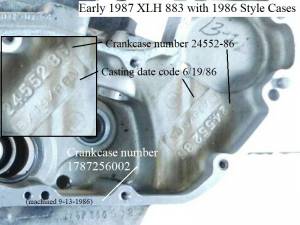 | 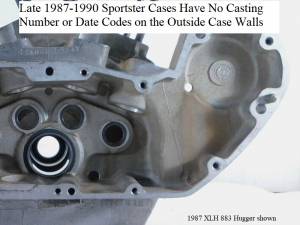 |
| 1988-1990 Left and Right Inner Case Date Codes 17) | |
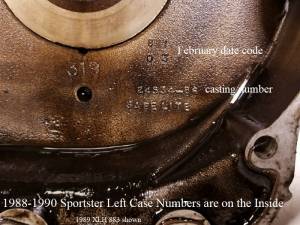 | 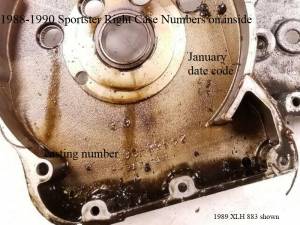 |
Crankcase Numbers
These numbers were originally stamped on the bottom of each case half in the early days and was known as Belly Numbers.
Crankcase numbers don't have anything to do with issuing a VIN.
1957-1985 crankcase#s will not tell you specific model info (XLH or XLCH) and is coded only for the XL family of engines.
1986-present crankcase#s will have a number code representing the size of the engine (883, 1100 or 1200cc).
1991-present motors changed the coding and numbering system several times. See below for those changes.
Engine serial / VIN numbers are added later after assembly.
Crankcase numbers tell you that a particular set of cases was paired up and finish machined together (line boring, cylinder base surfacing etc).
These numbers will tell the year model that the cases are intended to be used, the Julian date and sequential number that day.
The coding for the crankcase numbers changed in 1986.
HD Model Designation (changed to 2 digits) - Year Model Case (2 digits) - Julian Day of the Year (3 digits) - Sequential Number (3 digits)
Each case half should have the same exact crankcase numbers as they came assembled from the factory as such.
From 1986 to mid 1989, crankcase numbers were hand stamped with “Pann-Ident style” numbers.
Starting mid 1989, crankcase #s are “pin stamped” by machine with “block style” and look as though they were formed by a series of “center-punched” dots.
The punch marks are deep enough that they should be able to be recovered with acid after grinding.
The back-up system for the new automated process is the old style hand stamping.
Therefore, it is possible that in the event of a mechanical failure of the pin stamping machine;
Some crankcases, after mid-model year 1989, may have hand stamped numbers.
If that happened, Harley-Davidson will have records of what crankcase numbers were hand stamped.
Below are numbers found on different year Sportster cases and should only be used as a guide.
There may be other numbers that don't match the ones below but these have all been verified.
- On 1986-1990 motors
- Model designations were a 2 digit #, example (16 = XR1000, 17 = 883 Evo, 18 = 1100 Evo, 19 = 1200 Evo)
- The left crankcase is stamped on the outer primary wall (primary cover removed).
- The right crankcase is stamped horizontally on the outer side of the case under the gearcase.
- 1986-Mid 1989, the numbers are “hand stamped”.
- Mid 1989-up, crankcase numbers are “pin stamped” by machine.
- Example 10 digit crankcase number, 1786126015 translates to:
- 17 = 883 model
- 86 = 1986 model (case intended to be used for a 1986 model, not year it was cast)
- 126 = Julian day #126 of the year or May 6, 1986 (126th day of the year, taking into account the model year season)
- 015 = 15th off production line that day
- On 1991-1999 motors
- Models designations were a 2 digit #, example (24 = 883, 25 = 1200/1200C, 32 = / found on 1200S, 44 = / also found on 1200S)
- The left crankcase is stamped on the outer primary wall (primary cover removed).
- The right crankcase is stamped vertically on the outer side of the case on a vertical boss under the front of the gearcase.
The numbers run top to bottom.
On 1991-1997 motors, this front vertical boss is hollow (drilled from the bottom and plugged there).
Oil in the cam chest runs to the bottom of the crankcase thru this boss.
On 1998-1990 motors, this boss is not hollowed (cam chest oil is scavenged from the cam chest with a redesigned oil pump housing). - All crankcase numbers are “pin stamped” by machine.
- Example 10 digit crankcase number, 2592256026 translates to:
- 25 = 1200 or 1200C Sportster
- 92 = 1992 model (case intended to be used for a 1992 model, not the year it was cast)
- 256 = Julian day #256 of the year or September 13, 1991 (265th day of the year, taking into account the model year season)
- 026 = 26th off production line that day
- On 2000-2003 motors
- Models designations changed to a 3 digit number, example (024 = 883, 025 = 1200)
- The left crankcase is stamped on the outer primary wall (primary cover removed).
- The right crankcase is stamped vertically on the outer side of the case on a vertical boss under the front of the gearcase.
The numbers run bottom to top. This boss is not hollowed. - All crankcase numbers are “pin stamped” by machine.
- Example 10 digit crankcase number, 0240110273 translates to:
- 024 = 883 Sportster family
- 01 = 2001 model (case intended to be used for a 2001 model, not the year it was cast)
- 102 = Julian day #102 of the year or April 12, 2001 (102nd day of the year, taking into account the model year season)
- 73 = 73rd off production line that day
| 1986-1990 Sportster Crankcase Number Locations 18) | |
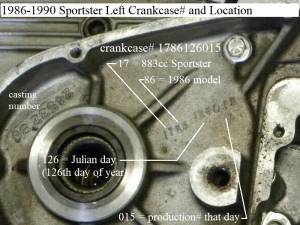 | 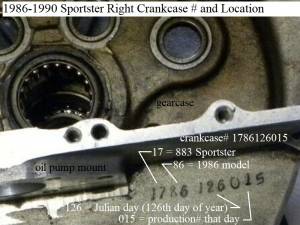 |
| 1991-1999 Sportster Crankcase Number Locations 19) | |
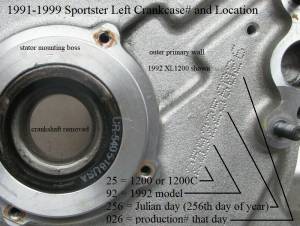 | 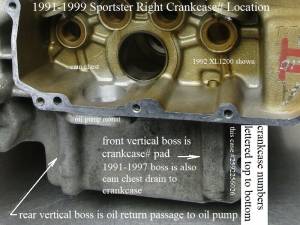 |
| 2000-2003 Sportster Crankcase Number Locations 20) | |
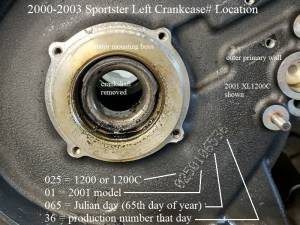 | 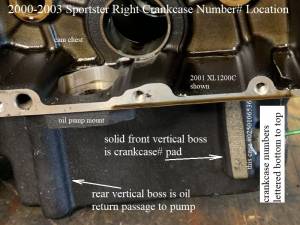 |
Case Match Numbers (1975-Up)
In addition to belly numbers, there is a second set of numbers on 75> motors on each case half that should match.
This was added the same time the left case crankcase number moved from the belly to the primary wall on 1975 models.
For lack of public documentation, we'll call these Case Match Numbers and they represent the fact that those two case halves were mated as a factory pair.
These will most likely be a letter(s) and numbers but the exact number set should be on the outside of each case half opposite one another.
The factory crankcase numbers should be the same and the case match numbers should also be the same.
There does not seem to be any connection between the case match numbers and belly numbers (no date coding visible on case match numbers).
- On 1986-1990 models, they'll be on each case half under the oil filter mount.
- On 1991-up models, they'll be on top of the cases near or under the starter.
| 1986-1990 Case Match Number Locations 21) |
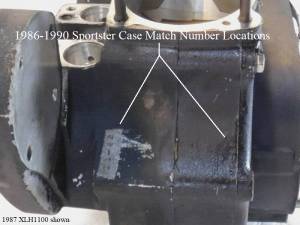 |
Serial or VIN Numbers
These numbers pertain to the whole bike, not just the engine. Coding for these numbers changed over the years.
Click Here to see the VIN page in the Sportsterpedia for specific information on serial/Vin numbers.
One Sportster may have many different parts, over the whole bike, than others, including engine parts.
The serial/VIN number was (most likely) the last number to be stamped onto the engine case from the factory.
1970-up Sportsters are titled to the frame only so the motor VIN number has nothing to do with ownership of the bike.
However, having the motor abbreviated VIN matching the frame VIN is a plus for those who want factory original parts.
And it helps toward the value (or haggle factor) on resell but the VIN is not the only factor in whether you have an original engine or bike.
Case Drains
The only intended drain on 1986-2003 models is the primary drain plug.
All models either drain engine oil from the oil tank or a hose from the tank.
1986-2003 cases have a vertical boss on the right case at the rear sump wall as an oil return passage from the crankcase to the oil pump passage.
Some year cases have a plug (like a small freeze plug) pressed into the bottom case plugging off oil passages.
Some cases have a set screw instead of the plug. But neither are supposed to used for draining engine oil.
There is no crankcase drain on any of these models.
However, the plug at the bottom of the rear vertical boss on the right case has been used to drain (most) of the oil in the crankcase.
It won't drain it all though.
The front vertical boss on 1991-1997 cases was used to lower the point where cam chest oil drained into the crankcase.
Removing that plug will not drain anything from the crankcase but it will drain whatever oil stacked up in it and the cam chest.
(shouldn't be that much oil in the cam chest anyway)
1998-2003 cases do not drain cam chest oil into the crankcase at all so the front vertical boss on the right case is not drilled / plugged.
Drains / plugs on the bottom of the cases:
- 1986-1990 cases:
- Primary drain plug
- Return passage plug on the bottom of the rear vertical boss, right side case beside sump wall
- 1991-1997 cases:
- Primary drain plug
- Return passage plug on the bottom of the rear vertical boss, right side case beside sump wall
- Cam chest drain plug on the bottom of the front vertical boss, right side case beside sump wall
- 1998-2003 cases:
- Primary drain plug
- Return passage plug on the bottom of the rear vertical boss, right side case beside sump wall
Left Case
Left Crankcase Oil Scavenge
On all models, oil scavenging to the pump and engine breathing is done by way of machining in the right case.
- 1986-1990 left cases use the same casting channel in the front as do 1977-1985 cases.
- The lower front wheel area has an expansion allowing air under the wheels to usher oil to the rear pocket of the sump.
- A channel is cast into the front case floor to steer oil flung off the wheels to the right case instead of the left case rear.
The channel dumps into the front half of the right case floor.
- 1991-1997 left cases do not have the cast-in channel in the front of the case floor.
- Forward oil that doesn't find it's way to the right case hits the rear wall and angled pocket to drain toward the right case rear.
- 1998-2003 left cases have a raised area in the front floor to catch fling oil in motion, dropping it into a cast in front pocket.
- The front pocket drains oil into the front of the right case.
- Forward oil that doesn't find it's way to the right case hits the rear wall and angled pocket to drain toward the right case rear.
Right Case
Upper Oil Feed Galley
The upper feed galley is a distribution point for oil feed from the pump.
- 1986-1990 models:
- The feed galley is a single horizontal hole drilled thru to an oil passage feeding both intake lifters only.
It is fed from passages in the cam cover. - The feed galley does not distribute oil to the crankpin (which is fed first from the cam cover oil passage).
- Lifter bores have holes between each intake the lifter and it's corresponding exhaust lifter bore for oiling them.
- 1991-2003 models:
- The horizontal hole was deleted in favor of a milled slot to transfer oil.
- The feed galley is fed from the added and holed casting in the right case between the feed galley and the built-in oil filter mount.
- The feed galley distributes oil to each lifter individually and also feeds to the crankpin by way of an oil passage in the cam cover.
- 1991 cases have the same slot as 1992-1999 cases do but without the tiny hole drilled in the bottom spraying #2 cam gear.
- 1991-1999 feed galleys are fed from an internal feed path thru the upper case from the filter mount. Feed galley only is exposed.
- 1992-1999 cases have a tiny hole drilled between the feed galley and the cam chest to purge high pressure oil and spray #2 cam gear.
- 2000-2003 feed galleys are fed from the same direction as 91-99 but the area in front of #1-#4 lifter is opened up.
The cam cover is also opened up so the cover is actually part of the oil feed path from the filter to the feed galley and lifters.
And using a pre-2000 cover will result in low oiling and engine damage due to the feed path profile changing.
| 1986-2003 Upper Oil Feed Galley Changes 28) |
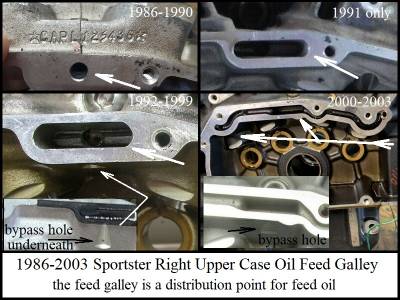 |
Oil Pump Mounting Boss and Oil Passages
Click Here to reference the Evo Sportster Oil Pump page in the Sportsterpedia.
Note: Mixing full oil pump assemblies and engine cases is much easier than mixing individual oil pump parts.
1986-present cases use a gerotor type oil pump but there is a major difference in plumbing between 86-90 models and 91-up models.
However, 1986-1990 cases can be modded to accept 1991-up oil pumps.
Click Here to reference the 5 Speed Oil Pump Conversion for 86-90 Evo engines.
- 1986-1990 cases have 2 oil passages on the pump mounting boss, feed to the motor and return to the pump.
(feed passages in the case and cam cover goes to the pinion shaft / crankpin first then up to the lifters)
It's essentially the same pump mount as in 1977-1985 motors.
The pump has ext. hose fittings for return line to the oil tank, lines to the oil filter pad and from the oil filter pad back into the pump.
The pump feeds the motor internally from there thru the feed hole in the oil pump mounting boss. - 1991-up cases have only 1 oil passage on the pump mounting boss, return to the pump.
Cases were redesigned to feed the top end first and then down to the pinion shaft / crankpin.
The oil pump was also redesigned with only 2 external fittings, feed line to the oil filter pad (then into the motor from there) and return line to the tank.
Right Case Oil Scavenge / Engine Breathing
1977-up motors scavenge oil from the crankcase thru an external vertical boss added to the outside of the rear sump area.
The boss is rifle drilled from the bottom to connect to the upper horizontal oil passage to the oil pump.
A hole is drilled from the inside of the right case to connect sump oil to the return passage.
The bottom of the rifled hole in the vertical boss is plugged.
- 1986-1990 cases:
- 86-90 motors drain the cam chest into the crankcase just below and forward of the pinion shaft thru a drilled hole in the lower cam chest wall.
- Additionally, there is a hole in the front portion of the case (back side of oil filter mount) for high pressure oil bypass discharge.
The oil filter pad is removable and has a built-in bypass valve in it.
The hole in the case is a discharge outlet for the bypass valve to dump oil directly into the cam chest and out of the feed oil path. - There are three breather holes in the cam wall (center smaller than both outers) carried over from Ironhead motors.
- Oil is fed to the engine from the bottom up.
Oil is pumped thru passages in the cam chest floor, thru the cam cover to the upper cam chest oil feed galley. - The oil pump has two additional fittings to run out to the oil filter and back to the pump.
- 1991-2003 cases:
- The oil filter pad for 1991-up models is built into the case and is not removable.
- Oil is fed to the engine from the top down. Oil is pumped to the oil filter pad by way of an external hose from the oil pump.
A drilled passage thru the upper case runs from the filter mount to the upper cam chest feed galley.
Then oil is pump thru passages in the cam cover to the pinion shaft to crankpin. - Oil pump information:
The oil pump design changed for the new routing system thru the cases.
Any 1991-1997 Sportster oil pump is a direct bolt-on for 1991-1997 motors (will bolt up but will not drain 1998-up cam chests).
Any 1998-present Sportster oil pump is a direct bolt-on for 91-up cases but has a designed inlet in the top of the pump for cam chest oil scavenge.
Will function on 1991-1997 cases. - The breather holes were redesigned using only two holes thru the cam wall with the middle hole from previous deleted.
The two remaining holes were enlarged in a rectangular fashion creating a bigger area for air to escape the crankcase. - 1991 cases (only), the oil pressure bypass was still used but installed thru the case into the back side of the oil filter mount.
Still dumping over pressured oil into the cam chest. - 1991-1997 motors drain the cam chest into the crankcase but farther down close to the bottom of the wheels than 86-90 motors.
A second vertical boss was added toward the front of the right case with a rifle drilled hole into the cam chest and plugged at the bottom.
Then a horizontal hole is drilled thru (from the inside) to the vertical boss connecting the oil passage. - 1998-2003 motors drain do not drain the cam chest to the crankcase. Oil in the cam chest is scavenged by an inlet built into the oil pump.
The front vertical boss on the right case is solid (not drilled) and is only used as a crankcase number pad. - 2000-2003 oil feed path in front of each lifter in the upper cam chest was milled instead of drilled.
The cam cover makes up the other half of the milled slot.
| 1986-1990 Sportster right case general oiling and breathing paths 31) | 1991 (only) Sportster right case general oiling and breathing paths 32) |
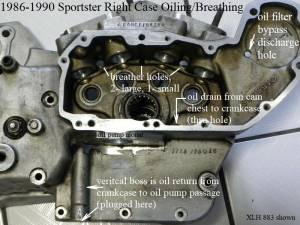 | 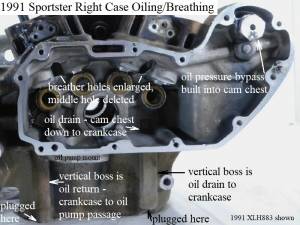 |
High Oil Pressure Bypass
- 1986-1990 cases do not have provisions for a high oil pressure bypass valve.
The bypass is built into the removable oil filter housing that bolts to the front of the right case.
There is however a discharge hole in the case from the back of the filter housing into the cam case.
Oil released from the bypass valve dumps to the cam chest floor to run the scavenge route back to the oil tank. - 1991 cases have the oil filter mount cast into the right case (not removable).
The high pressure bypass is incorporated inside the case behind the oil filter mount and very noticeable with the cam cover off. - 1992-Up cases also have a high pressure oil bypass. It's not a valve but rather a tiny hole drilled into the upper right case.
The hole is drilled thru the case at the bottom of the upper feed galley above #2 cam gear. It doubles as an added spray of oil onto #2 cam gear.
But the hole is app .060” so it won't spray a lot of oil unless the pressure gets to a certain point in the oil feed path.
| 1986-2003 high pressure bypass configurations 39) |
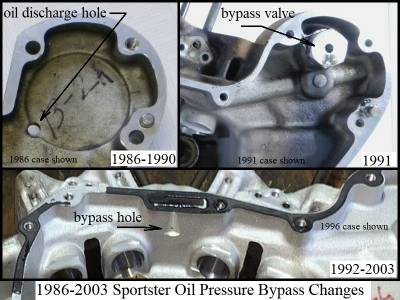 |
Primary / Transmission External Vent (1986-Present)
Click Here to reference the Trans/Primary Oiling page in the Sportsterpedia.

